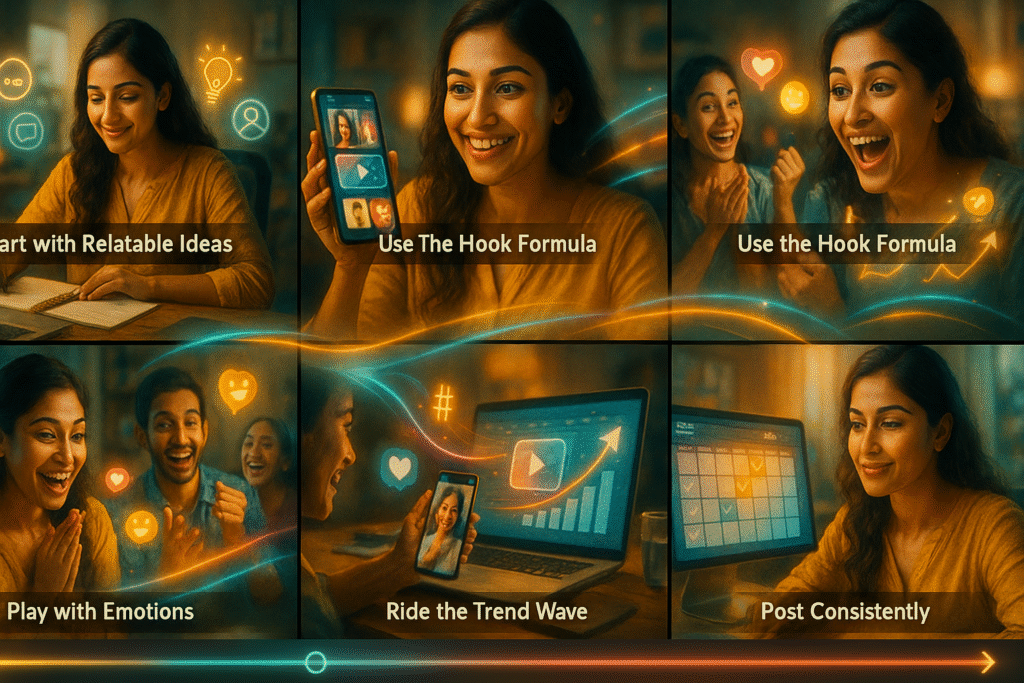It’s 11:30 p.m. You’re lying on your hostel bed, scrolling through reels. Suddenly, you stop. A random guy reviewing “pani puri at a street stall” has 2 million views. Your first reaction: “Arey yaar, this is viral now?”
And then the thought hits you: “If he can go viral, why not me?”
Welcome to the dream of every digital native – creating viral content. But here’s the reality check: viral content doesn’t just “happen.” It’s not magic. It’s science, psychology, timing, and a little bit of luck.
If you’re a digital marketing student or young professional, this guide will show you how to create viral-worthy content step by step – without boring you like a textbook.
What Does “Viral” Really Mean?
Before we jump into strategies, let’s clear the air.
Viral doesn’t mean millions of views only. It means your content spreads like gossip in a college canteen – fast, wide, and unstoppable.
High reach (lots of people see it)
High engagement (people like, share, comment)
Relatability (audience says: “This is so me!”)
Remember: Going viral is about impact, not just numbers. Even 10,000 views can be viral if your usual reach is 200.

The Psychology of Viral Content
Why do people share? Think about it.
To look cool or funny (“Let me send this meme to my friends.”)
To look informed (“I’ll share this article so people know I’m smart.”)
To feel connected (“This reel reminds me of hostel life. Sharing with my gang.”)
Viral content = content that makes people feel something strong enough to hit “share.”

7 Steps to Create Viral Content
1. Start with Relatable Ideas
If your audience can’t connect, they won’t care.
Students relate to: exams, hostel food, last-minute assignments, college crushes.
Young professionals relate to: work-life balance, bosses, Monday blues, coffee addiction.
Ask yourself: “Will my friends laugh, nod, or share this?”
2. Make It Snackable
Nobody has patience for a 10-minute rant. Viral content is short, crisp, and instantly engaging.
Instagram Reels: 7-15 seconds work best.
TikTok (where it’s available): under 30 seconds.
Tweets/X posts: under 280 characters.
Rule: “If it’s boring after 3 seconds, it’s dead.”
3. Use the Hook Formula
The first line or 3 seconds decide everything.
Examples of hooks:
“What happens when a broke student enters Starbucks…”
“This trick saved me 50% on my exam stress.”
“POV: Your professor catches you bunking class.”
Start strong, or people scroll away.
4. Play with Emotions
Content that makes people laugh, cry, or say “OMG so true” spreads fastest.
Humor → Memes, jokes, spoofs
Inspiration → Success stories, struggles
Nostalgia → 90s cartoons, school/college memories
Shock/Surprise → “You won’t believe this…”
Formula: Emotion = Shareability.
5. Ride the Trend Wave
Trends are like metro trains – you miss one, another comes in 5 minutes. But timing is everything.
Trending songs on Instagram Reels.
Viral challenges (like the Ice Bucket Challenge back then).
Popular hashtags (#MondayMotivation, #ExamStress).
Mix trend + originality = viral potential.
6. Design for Sharing
Think beyond likes. Create content people want to send to their friends.
Memes (“This is literally you, bro.”)
Lists (“5 types of professors in every college.”)
Relatable dialogues (“Beta, placement kab hai?”)
The easier it is to share, the higher the chance of virality.
7. Post Consistently, Not Desperately
Nobody goes viral on their first try (unless they’re insanely lucky). It takes attempts, learning, and consistency.
Post 3–4 times a week.
Track what works.
Double down on successful formats.
Viral is not a one-hit wonder; it’s a habit.

Pro Tips to Boost Viral Chances
Strong visuals – People process visuals 60,000 times faster than text.
Subtitles on videos – Many watch without sound.
CTA (Call to Action) – Ask people to “tag a friend” or “share if you agree.”
Collaborations – Partner with peers or micro-influencers.
Timing – Post when your audience is active (usually evenings for students).
Tools Students Can Use (Free & Easy)
Canva → Create graphics/memes.
CapCut/InShot → Edit reels and short videos.
ChatGPT → Generate ideas, hooks, captions.
Google Trends → Spot trending topics.
Instagram Insights → See what’s working.
A Mini Case Study
Meet Neha, a second-year B.Com student. She started making funny reels about “Types of Students in Online Classes.”
Week 1: 200 views.
Week 2: One reel hit 20,000 views (students related to it).
Month 3: She crossed 50,000 followers.
Now, she earns through brand collaborations. Her formula? Relatable + Consistent + Trend-savvy.

Mistakes to Avoid
Copying content blindly → You’ll be ignored.
Overusing hashtags → Looks spammy.
Being too promotional → People follow for fun, not ads.
Giving up after 2–3 flops → Virality takes patience.
Final Thoughts
Creating viral content is like preparing for exams. Some students cram overnight and get lucky. Others study consistently and always score well.
The truth is, you can’t force virality—but you can increase your chances.
If you’re a student or young professional, start small. Post something relatable, short, and emotional. Experiment, learn, and adapt. One day, your reel or post might just blow up while you’re sleeping. And when your phone explodes with notifications, remember—you didn’t just go viral, you understood the game.
So, are you ready to stop scrolling and start creating? Because the next viral post might just have your name on it.
Pro Tip from experience: Don’t chase virality, chase value. Viral posts get you attention, but valuable posts keep people with you. Build both.

